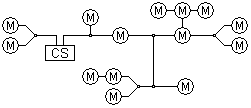
LocoNet's "ethernet like" architecture seems interesting and more advanced than the systems used by other DCC manufacturers. But, at the numbers we are talking about (a few controllers and perhaps 10-20 decoders), does it really make a difference?
If your system operates with a few throttles and other devices attached any of the commercially available systems will work today. But what about tomorrow? Remember when a hard-drive bigger than 32Mb seemed excessive- and remember when DOS had to change to 16bit FATs/ directories? Also, the LBA access change at 540Mb also once seemed unthinkable!!
The network structure of LocoNet is very important for your future system expansion. If you want to consider adding features like signaling, transponding and detection, the network structure will determine how easy this is to accomplish. To make expansion easy, Digitrax LocoNet offers a "plug and play" strategy that lets your system grow by simply plugging in new components. LocoNet is set up so that it can run systems of any size efficiently with the ability to expand system capabilities as you are ready.
As a cab bus type system is expanded to include more and more throttles and other devices, the first problem that you might see is delayed response time between when you send a command and when it is implemented on the layout. This is called latency. This means that when you change, for example, the locomotive speed there is a noticeable delay from the time you send the command and the time it is executed by the system. Digitrax LocoNet uses a carefully crafted CSMA/CD strategy (akin to the universally used "Ethernet" of computer LAN's) because it offers excellent performance for a scalable, practical and cost-efficient connection backbone for model railroad applications.
This simple CSMA/CD choice alone is NOT sufficient to ensure the performance demanded by today's users. Along with a message and access strategy, LocoNet employs a carefully crafted, balanced and synergistic combination of layers of physical, electrical, messaging, error control, data base and distributed system concepts. Our design concepts are validated by many existing state-of-the-art practices, such as the ISO layer model for open systems connection. Note that a simple communication bus and master-slave type architecture, as developed and used in mainframes in the 1960's and 1970's is not enough in the sophisticated true network environment of the 1990's and the next millennium.
LocoNet was developed to protect your equipment & time investments by incorporating expansion capabilities. We have committed the extra time needed to develop LocoNet as a scalable system architecture before we designed and offered ANY products for sale. As new capabilities like signaling, transponding, multiple PC control and a variety of advanced software and hardware come on line, the promise of LocoNet will be fully realized on model railroads around the world.
Material originally published as part of The Digitrax Big Book Of DCC